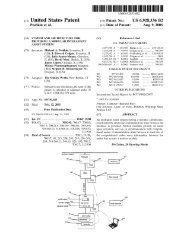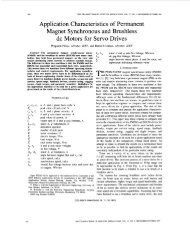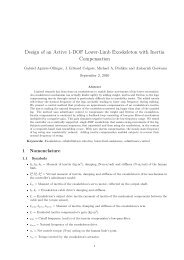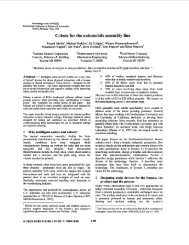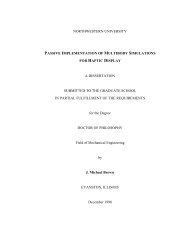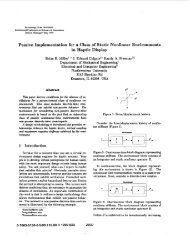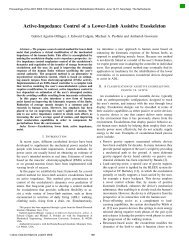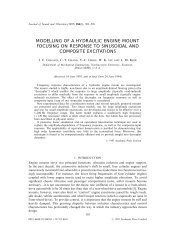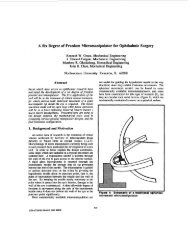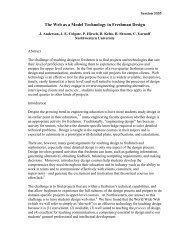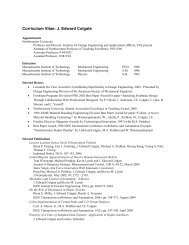force sensors for human/robot interaction - Colgate - Northwestern ...
force sensors for human/robot interaction - Colgate - Northwestern ...
force sensors for human/robot interaction - Colgate - Northwestern ...
Create successful ePaper yourself
Turn your PDF publications into a flip-book with our unique Google optimized e-Paper software.
need to be worried about. (Due to the<br />
compliance matrix, other unwanted <strong><strong>for</strong>ce</strong><br />
components, f z , τ x , and τ y , do not have this<br />
concern.)<br />
It was found <strong>for</strong> the photosensor used, QT<br />
Optoelectronic’s OPB706A reflective sensor,<br />
that a decent trade-off between sensitivity and<br />
linearity of the sensor response could be obtained<br />
if the maximum displacement allowed by the<br />
flexure was ±1mm.<br />
4. Three-axis <strong><strong>for</strong>ce</strong> sensor design<br />
Another design <strong>for</strong> a similar <strong><strong>for</strong>ce</strong> sensor is<br />
shown in figure 5. In this design, there are three<br />
pairs of beams in series. An inner piece is<br />
attached at the 2 locations labeled B (One is<br />
hidden.). An outer piece is attached at the 4<br />
locations labeled A. The heavily shaded beams<br />
are thick and do not bend significantly. The<br />
beams labeled a, b, and g allow flexing in the x,<br />
y and z directions respectively. Each pair of<br />
beams allows only motion in one direction. All<br />
together this design allows motion only in x, y<br />
and z, and allows no twisting of the device. As<br />
be<strong>for</strong>e, photo<strong>sensors</strong> could be used to measure<br />
displacements. There would then be 3 pairs of<br />
<strong>sensors</strong> instead of two.<br />
This design is more complicated. In addition,<br />
it lacks some of the compactness of the first<br />
design, which can be relatively short in the z<br />
direction. However, this design is insensitive to<br />
all torques and can withstand large torques<br />
without breaking or affecting readings.<br />
Figure 5<br />
5. Measurements<br />
Linearity, noise, and DC offset drift<br />
measurements will be added as soon as<br />
completed.<br />
6. Summary<br />
A new <strong><strong>for</strong>ce</strong> sensor design was described in<br />
this paper. It is much cheaper and easier to<br />
construct than existing commercial <strong><strong>for</strong>ce</strong> <strong>sensors</strong>.<br />
The reduced degrees of freedom (two or three<br />
in contrast to six) allows a different class of<br />
flexures to be used, two of which are mentioned<br />
above. These flexures have a diagonal<br />
compliance matrix.<br />
The greater allowable compliance in<br />
<strong>human</strong>/<strong>robot</strong> applications makes new simpler and<br />
cheaper <strong><strong>for</strong>ce</strong> <strong>sensors</strong> possible. In addition it<br />
allows the use of new types of <strong>sensors</strong>.<br />
The <strong><strong>for</strong>ce</strong> sensor described above allows<br />
measurement of <strong><strong>for</strong>ce</strong>s in a plane. It is<br />
insensitive to other <strong><strong>for</strong>ce</strong> components. These<br />
<strong><strong>for</strong>ce</strong> components do not significantly bend the<br />
flexure, thus they do not have to be measured and<br />
then cancelled. The designs can be modified so<br />
that these <strong><strong>for</strong>ce</strong> components can be very large,<br />
and still not break or significantly bend the<br />
flexure.




